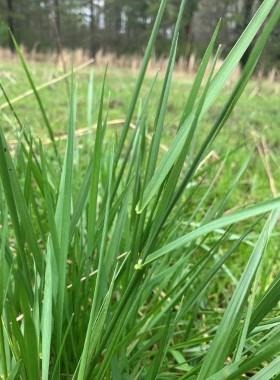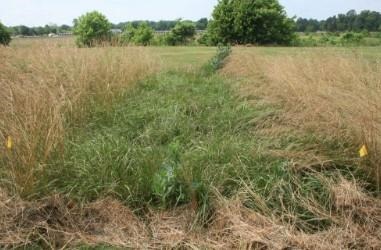Learn more about herbicide options for suppressing tall fescue seedheads, including how to mitigate the harmful effects to livestock and the effective forage- labeled herbicides.
Tall fescue (Schedonorus arundinaceus (Schreb.) Dumort.) is the dominant cool-season perennial forage species found throughout the mid-South. In Alabama, it persists mainly in the northern two-thirds of the state. Across the United States, the ‘Kentucky 31’ variety, specifically, is used extensively on millions of acres because it is adaptable, easy to establish, has a long life span, and potentially good nutritive value. These positive qualities are attributed, in part, to a mutual association with a fungus (Epichloë coenophiala) or endophyte that resides within the plant. However, this fungal endophyte sometimes produces ergot alkaloids that may accumulate in grazing animals under certain environmental stresses. When consumed, these are often harmful to livestock, resulting in reduced weight gain, fescue foot, and the potential for reduced reproductive performance.

Figure 1. Tall fescue nearing flag leaf growth stage. Herbicides should be applied at or before the flag leaf growth stage for optimum seedhead suppression.
Mitigating Harmful Effects to Grazing Livestock
Endophyte-Free Varieties
Early developments to produce tall fescue without ergot alkaloids resulted in removing the viable endophyte. As a result, forage nutritive value improved, but the loss of plant vigor caused certain varieties to suffer and decline from environmental stressors. Endophyte-free varieties now have improved agronomic potential to persist longer under grazing conditions.
Novel Endophyte Varieties
Novel endophyte strains were developed to increase plant persistence and animal performance without the negative implications of the ergot alkaloids. Due to the aggressive nature of the toxic, endophytic tall fescue, proper renovation methods are required before establishing these novel varieties to minimize competition. Toxic tall fescue will likely encroach into newly established fields if not completely removed.
Interseeding Legumes
If field renovation is not an option, you can still mitigate the toxic effects from older stands of the endophytic varieties like ‘Kentucky 31’ by interseeding legumes. Incorporating clovers, for example, can greatly improve forage quality and livestock performance. Careful grazing management is required to maintain species balance.
Seedhead Suppression
In further attempts to mitigate toxicity, chemical plant growth regulators have been proven to minimize tall fescue seed development. Since the early 1990s, these active chemical ingredients have also improved tall fescue’s nutritive value by delaying plant maturity, increasing crude protein, and decreasing neutral detergent fiber. Since ergot alkaloids become highly concentrated in seedheads where cattle and horses selectively graze them, certain forage-labeled products applied during the vegetative growth stages have been successful at minimizing seed production.
Effective Forage-Labeled Herbicides
Research conducted in the Southeast has proven the effectiveness of certain acetolactate synthase (ALS) inhibiting herbicides on tall fescue seedhead suppression. Sulfonylurea herbicides, for example, have relatively low use rates, have a favorable environmental profile, are short-lived in soils (1⁄2 life = 6 – 20 days) and have high water solubility. Forage-labeled products are most successful when applied with properly calibrated broadcast spray equipment. Effective treatments are usually delivered in 15 to 25 gallons of water per acre during the spring when tall fescue is at the late vegetative growth stage.
Seedheads were successfully suppressed at least 76 percent by both rates of nicosulfuron + metsulfuron (Pastora), imazapic (Plateau), and sulfosulfuron at 0.75 ounce ai per acre (Outrider 1 ounce/acre) by 3 months after treatment. Plant injury is expected (10 percent to 25 percent) within the first few weeks when using higher rates of nicosulfuron + metsulfuron (>0.5 ounce/acre Pastora) and imazapic (>1.5 fluid unces/acre Plateau), but plants usually outgrow any visual injury symptoms under favorable growing conditions.
If livestock or forage producers do not have the option for complete pasture renovation or the choice of planting novel tall fescue varieties, chemical seedhead suppression could be a viable tool. Note that these recommendations are intended for use in tall fescue pastures. Severe injury or forage losses may occur from many of these herbicides if applied in mixed grass swards that include bahiagrass specifically. In a system where infected tall fescue and clover mixtures are desirable, imazethapyr (up to 4 fluid ounces/ acre Pursuit) would be the treatment of choice for tall fescue seedhead suppression because of its safety on numerous legume species. Low use rates from selected herbicides may present challenges if spray equipment is not properly calibrated. Slight reductions in forage foliar heights are possible with ALS herbicides, but any injury incurred in the form of chlorosis is negligible by 3 months after treatment.

Figure 2. Low rates of appropriate herbicides applied during the vegetative growth stage can effectively manage tall fescue seed production and the threat of ergot alkaloid toxicity to grazing livestock.
Table 1. Average Tall fescue Seedhead Suppression from Herbicides Evaluated in Three Field Trials over 2 Years
*Herbicide active ingredient rate in pounds per acre.
**Percent tall fescue seedhead suppression on 0 to 100% scale. 100% = complete control or no seedheads.
Source : aces.edu